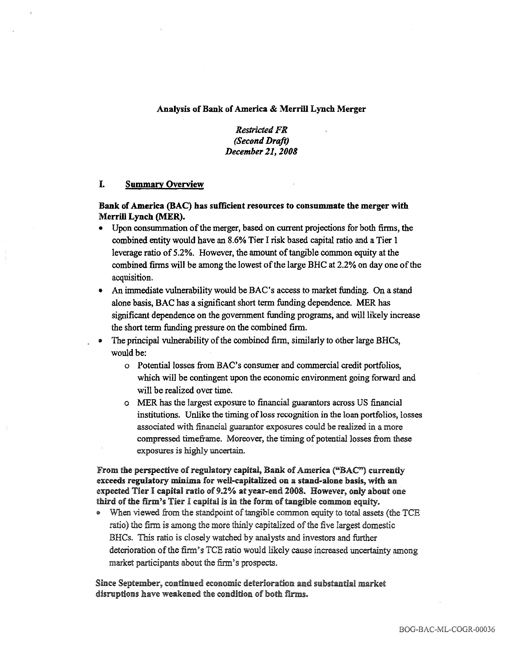Federal Reserve Analysis
- Second Draft
- 3 pages
- Restricted FR
- December 21, 2008
I. Summary Overview
Bank of America (BAC) has sufficient resources to consummate the merger with Merrill Lynch (MER).
- Upon consummation of the merger, based on current projections for both firms, the combined entity would have an 8.6% Tier I risk based capital ratio and a Tier 1 leverage ratio of 5.2%. However, the amount of tangible common equity at the combined firms will be among the lowest of the large BHC at 2.2% on day one of the acquisition.
- An immediate vulnerability would be BAC’s access to market funding. On a stand alone basis, SAC has a significant short term funding dependence. MER has significant dependence on the government fimding programs, and will likely increase the short term fimding pressure on the combined firm.
- The principal vulnerability of the combined firm, similarly to other large BHCs, would be:
- Potential losses from BAC’s consumer and commercial credit portfolios, which will be contingent upon the economic environment going forward and will be realized over time.
- MER has the largest exposure to financial guarantors across US financial institutions. Unlike the timing ofloss recognition in the loan portfolios, losses associated with financial guarantor exposures could be realized in a more compressed timeframe. Moreover, the timing of potential losses from these exposures is highly uncertain.
From the perspective of regulatory capital, Rank of America (“RAC,,) currently exceeds regulatory minima for well-capitalized on a stand-alone basis, with an expected Tiel’ I capital ratio of 9.2% at year-end 2008. However~ only about one third of the firm’s Tier I capital is in the form of tangible common equity.
- When viewed from the standpoint of tangible common equity to total assets (the TCE ratio) the firm is among the more thinly capitalized of the five largest domestic BHCs. This ratio is closely watched by analysts and investors and further deterioration of the firm’s TCE ratio would likely cause increased uncertainty among market participants about the fum’s prospects.
Since September, continued economic deterioration and substantial market disruptions have weakened the condition of both firms.
- MER’s deterioration has been substantially worse than SAC’s and all but ensures that the firm could not survive as a stand-alone entity without raising substantial new capital (and\or government support) that is unlikely to be available given the uncertainty about its prospects and further future losses .
- Management now projects Q4 after-tax losses of roughly $14 billion for MER, and approximately a $1.4 billion after-tax quarterly net loss for SAC, which for BAC represents more than four times management’s projected losses from just two weeks ago. ‘The losses at MER will erode over 50% of MER’s tangible common equity.
While the extent of the market disruptions that have occurred since mid-September were not necessarily predictable, BAC management’s contention that the severity of MER’s losses only came to light in recent days is problematic and implies substantial deficiencies in the due diligence carried out in advance of and subsequent to the acquisition .
- In the merger proxy statement and investor presentations the firm explicitly asserts that it has an understanding of MER’s business activities, financial condition and prospects as well as an understanding of the outlook for the firm based on prospective economic and market conditions.
- Staff at the Federal Reserve has been aware of the finn’s potentially large losses stemming from exposures to financial guarantors, which is the single largest area of risk exposure and driver of recent losses that have been identified by management. These were clearly shown in Merrill Lynch’s internal risk management reports that BAC reviewed during their due diligence.
- The potential for losses from other risk exposures cited by management, including those coming from leveraged loans and trading in complex structured credit derivatives products (‘correlation trading’) should also have been reasonably well understood, particularly as BAC itself is also active in both these products.
- Having done a quick analysis on the specific positions/exposures at MER that generated the largest losses for MER in Q4, FRS staff see no clear indication that they were driven by overly aggressive marking down of positions in advance of the acquisition. This general conclusion notwithstanding, some of the marks do appear somewhat conservative and the appropriateness of the timing of the impairment charge taken against goodwill is hard to assess. On the other hand. credit valuation adjustments against financial guarantors are not particularly aggressive relative to those staffhas observed at other firms.
The combined firm remains vulnerable to a continuing downturn.
- At the time of the completion of the merger, based on current projections for both firms, the combined entity would have an 8.6% Tier 1 capital ratio, and a TCE ratio ofless than 2.2%. This is in relation to BAC’s stand-alone ratios of9.2% and 2.6%, respectively.
- Based on stress analysis performed by staff, under moderate and severe stress scenarios the combined BAC-MER finn would be among the most vulnerable of the largest domestic BHCs, but not substantially more vulnerable than many others.
- In the event that actual losses were in line with stress projections, TCE and Tier I capital would be substantially eroded, with Tier I risk based capital ratios of 6.4% and 4.0%, respectively, under the moderate and severe stress tests.
- Resulting from the impacts of a moderate or severe recession, our scenario analysis suggests that the combined entity would need to raise roughly $21 billion and $67 billion of Tier I capital, achieve a Tier I risk-based capital ratio of 7.5% at year-end 2009.

